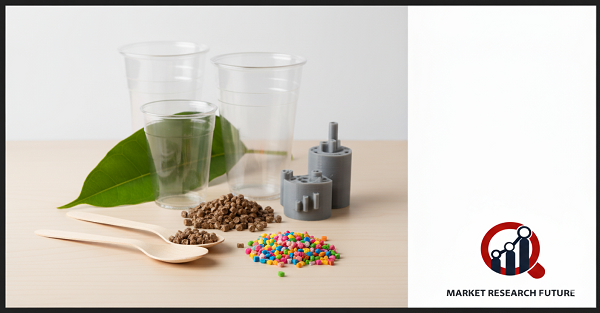Market Research Future (MRFR) has published a cooked research report on the “Biopolymers and Bioplastics Market” that contains information from 2019 to 2035.
The Biopolymers and Bioplastics Market is estimated to register a CAGR of 4.27% during the forecast period of 2025 to 2035.
MRFR recognizes the following companies as the key players in the Global Biopolymers and Bioplastics Market: BASF SE (Germany), Arkema (France), Braskem (Brazil), Biome Bioplastics Limited (US), Covestro (Germany), Kaneka Corporation (Japan), Mitsubishi Chemical Corporation (Japan), United Biopolymers (US), NatureWorks Inc. (US), Plantic Technologies Limited (Australia), and SKYi Composites (India).

Biopolymers and Bioplastics Market Highlights
The Biopolymers and Bioplastics Market is expected to register a CAGR of 4.27% during the forecast period and is estimated to reach USD 36.61 billion by 2035, up from USD 23.11 billion in 2024.
The main reasons for this growth are that eco-friendly packaging is becoming more popular and more people are learning about how traditional plastics harm the environment. People all over the world are moving toward biodegradable and renewable options because they are worried about the environment and because governments are making it harder to use single-use plastics. More and more industries, including packaging, automotive, agriculture, and consumer goods, are choosing bioplastics because they break down and can be composted.
The market expansion is further supported by technological advancements in biopolymer production, such as the development of high-performance materials like PLA, PBAT, and PHA, which match the strength and flexibility of traditional plastics. Universities and research institutions, including the University of California, the University of Rochester, and the University of Rhode Island, are actively collaborating with industry players like Mango Materials to develop next-generation biodegradable plastics designed for ocean degradation, highlighting the increasing focus on environmental sustainability.
Also, more government programs and rules that encourage the use of bio-based materials are speeding up adoption. The European Union's rules against single-use plastics and the U.S. government's support for renewable alternatives are pushing businesses to invest in technologies that make materials that are better for the environment. Companies like LG Chem and ADM have also worked together to build big lactic acid production plants in the U.S. These will make the supply chain for making bioplastics stronger.
Segment Analysis
The Global Biopolymers and Bioplastics Market has been segmented based on Type, Non-Biodegradable Type, End-Use Industry, and Region.
Based on Type, the market includes Biodegradable bioplastics such as Polylactic Acid (PLA), Starch Blends, Polybutylene Adipate Terephthalate (PBAT), and Polyhydroxyalkanoate (PHA). The Polylactic Acid (PLA) segment dominated the market in 2024 due to its high demand across packaging and textile applications and its ability to meet eco-friendly material standards.
Based on Non-Biodegradable Type, the market includes Bio-PE, Bio-PA, Bio-PET, Bio-PTT, and Others. Among these, the Bio-PE segment dominated the market due to shifting consumer preferences toward renewable-based plastics with lower carbon footprints. For instance, DSM Engineering Materials launched StanylB-MB (Bio-based Mass Balanced), which contains up to 100% bio-based material and reduces the product line’s carbon footprint by half.
Based on End-Use Industry, the market is categorized into Packaging, Consumer Goods, Automotive & Transportation, Textiles, Agriculture & Horticulture, and Others. The Packaging segment held the largest share in 2024 and is projected to continue dominating during the forecast period due to the rapid growth of e-commerce and demand for sustainable packaging materials. Rigid and flexible packaging applications, in particular, are witnessing a surge in bioplastics adoption to minimize environmental impact.
Regional Analysis
By Region, the Biopolymers and Bioplastics Market is segmented into North America, Europe, Asia-Pacific, and the Rest of the World.
The Asia-Pacific region dominates the global market, driven by the presence of major plastic manufacturers and increasing adoption of sustainable materials in emerging economies like China and India. The region’s strong manufacturing base, combined with rising government support for green technologies, positions it as the fastest-growing market during the forecast period.
Europe holds the second-largest market share, supported by strong government policies such as REACH and EPA regulations, along with the growing adoption of bioplastics across industries. Countries like Germany, France, and the UK are leading in research and industrial-scale implementation of biopolymer technologies.
North America is expected to register significant growth, with strong R&D activities and investments from multinational corporations in developing advanced bioplastics. Partnerships like the LG Chem–ADM collaboration in the U.S. reflect the region’s strategic commitment to expanding bio-based production capacities.
Key Findings of the Study
- The Global Biopolymers and Bioplastics Market is expected to reach USD 36.61 billion by 2035, at a CAGR of 4.27% during the forecast period.
• Asia-Pacific accounted for the largest and fastest-growing market share in 2024.
• Polylactic Acid (PLA) was the dominant biodegradable type in 2024.
• Packaging remained the largest end-use industry segment, driven by e-commerce and sustainable consumer trends.
• BASF SE, Braskem, NatureWorks Inc., Mitsubishi Chemical Corporation, and Arkema are recognized as leading players driving innovation in biopolymer and bioplastic technologies.
Related Reports
https://www.marketresearchfuture.com/reports/biopolymers-and-bioplastics-market-10807